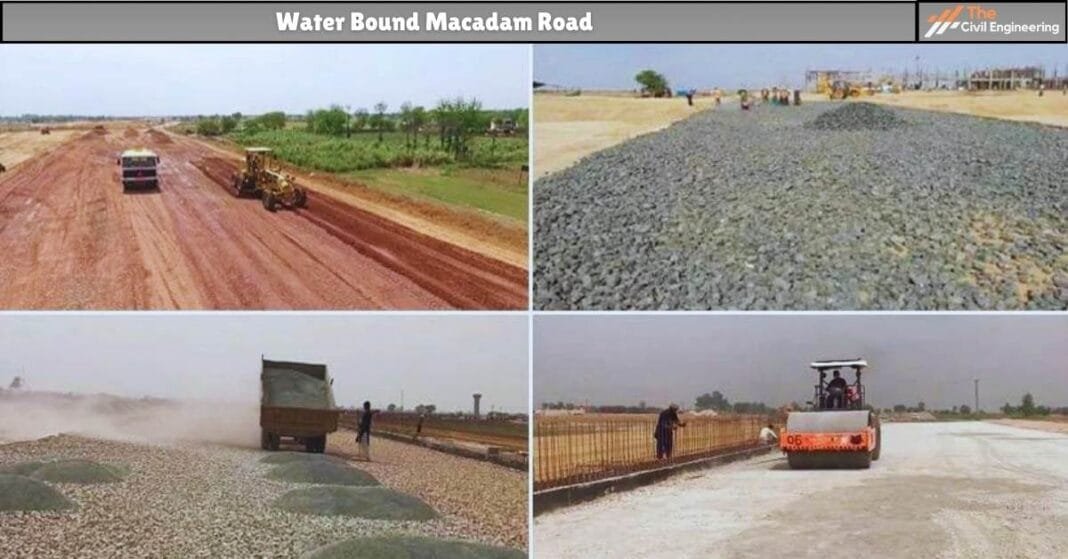1. Introduction
Water Bound Macadam Road can be abbreviated as WBM Road.
The concept of the WBM road was developed by Scottish engineer John Loudon Macadam.
It is the most commonly used road construction technique for over more than 190 years.
WBM Road is the type of macadam road whose wearing coarse is constructed with clean crushed aggregates which are mechanically interlocked by rolling and bounded together with the mixture of filler material( sand or clay) and water that is laid on a prepared base course.

WBM road produces dust while providing service. Powder of Calcium Chloride or Bituminous Materials can be spread on the surface of the road to minimize dust.
This road is not suitable for fast-moving vehicles and rubber-wheeled vehicles. It is suitable for iron wheeled vehicles like tongas, bullock carts, etc.
It is the first stage in road construction. In many village and rural areas; WBM road is constructed initially and further improved or paved when the fund is available.
2. Construction of Water Bound Macadam Road (WBM Road )
Construction WBM road involves the following steps;
a. Preparation of Sub-grade
i. Cutting and filling of soil are done according to requirement.
ii. The level of the sub-grade is decided by subtracting the total thickness of the pavement from the finished level.
iii. Sub-grade is thoroughly compacted using rollers of weight 6 to 10 tones. Water is sprinkled properly on the subgrade before rolling.
iv. If any low pit is developed during the rolling; it must be rectified and the surface should be brought to the required grade.
v. In rocky areas; sub-grade is not rolled.
vi. In clayey soil; a layer of granular materials like sand, mourn, gravel, or kankar is provided. The layer should have a thickness of 10 to 15 cm. After the provision of the layer, compaction is done.
b. Construction of Sub-Base
For providing lateral confinement of aggregates, the shoulders having a thickness equal to the compacted WBM layer should be constructed in advance.
i. On a prepared sub-grade; boulders, broken stones or over burnt brick in layers of 15 cm thickness are spread. The size of these materials should range between 10 cm to 20 cm.
ii. Total width of the sub-base should be 60 cm more than the width of the pavement. (i.e. 30 cm more on each side)
iii. Then compaction is done using the roller of weight 6 to 10 tones.
c. Construction of Base
i. If the road soil is stable then there is no need for the provision of the base course because the sub-base course performs the work of the base course.
ii. In the case of unstable soil; one layer of material is added over the sub-base course. This added layer is referred to as the base course.
iii. The materials like boulders, broken stones, over burnt bricks, etc are used in the preparation of the base course.
iv. Provision of bricks or stones at the earthen kerbs is done to prevent the outward movement of the materials.
v. Then compaction is done.
d. Preparation of Wearing Course
The wearing course should be provided in one or two layers.
The thickness of the wearing course should not exceed 10 cm.

Fig: Screening of material
Steps in the preparation of wearing course are:
i. After the preparation of the base course; screening materials are applied to fill up the voids.
ii. Screening materials are spread over the base course uniformly.
iv. Three or more layers of screening materials are provided.
v. After that, the binding material is applied to the surface in two or three layers at a uniform rate.
vi. Every layer of the binding material is rolled after adding adequate water.
e. Opening to Traffic
i. The road surface is then allowed to cure or set overnight after final compaction. If depressions are found the next day; then they are filled using binding materials or screening materials.
ii. The road is allowed to dry properly before allowing traffic.
3. Advantages of Water Bound Macadam Road
a. It is economical as compared to the bituminous road.
b. The quality of WBM is superior because the materials are graded carefully and the resulting mass is void-free.
c. The interlocking of aggregates provides adequate strength.
d. Made from local materials.
e. No skilled manpower is required.
f. If constructed properly; it can handle the traffic load of 900 tones per lane per day.
4. Disadvantages of Water Bound Macadam Road
a. Not suitable for fast-moving traffic and rubber-wheeled vehicles.
b. Use of clay or sand as a binding material does not provide sufficient bonding between aggregates.
c. It has a short life.
d. It produces dust during its service.
e. It is permeable.
| Read More: Earth Road |
| Read More: Low-Cost Road |


